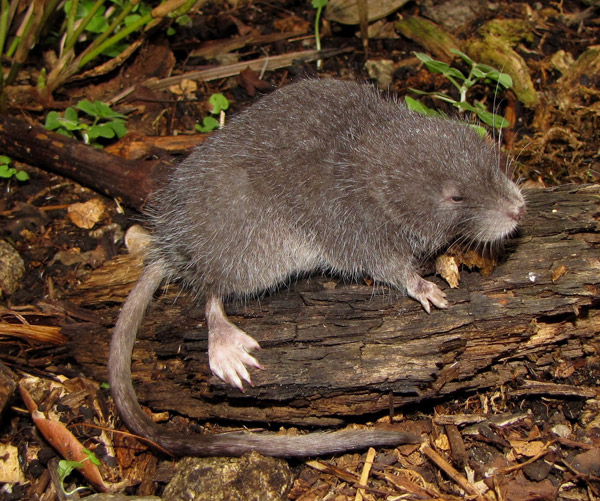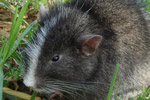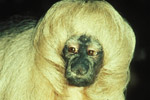
This potentially new lizard species was discovered on the last day of a survey in a cloud forest in Andean Peru. Photo: Luis Mamani.
A group of Peruvian and Mexican scientists say they have uncovered at least six new species near South America’s most famous archaeological site: Machu Picchu. The discoveries include a new mammal, a new lizard, and four new frogs. While the scientists are working on formally describing the species, they have released photos and a few tantalizing details about the new discoveries.
The new mammal—which isn’t named yet—is an bizarre-looking aquatic rodent in the Chibchanomys genus, which until now was only made up of two species. The new mammal doesn’t have any external ears and sports hairs between its toes and on the sides of its legs to help it maneuver through streams.
“These aquatic rodents are among the rarest and little known in America,” the scientists write in a press release.
The discoveries are the result a 2012 survey of Machu Picchu National Park and the Historic Sanctuary of Machu Picchu, specifically in cloud forests near Wiñayhuayna, another archaeological site on the Inca Trail heading towards Machu Picchu. Despite receiving generally less attention than lowland rainforests, cloud forests are often hugely-rich in species found no-where else and many new species stem from these habitats.

This new aquatic mammal has evolved to handle life in the cloud forest streams. Photo by: Alexander Pari.
The team, which was led by Horacio Zeballos the curator of the Department of Mammalogy at the Museum de Arequipa and Gerardo Ceballos from the Instituto de Ecología of the Universidad Nacional Autónoma de México, also uncovered what they think are four new frogs. These include one in the genus Telmatobius, which spends its life in small pools built by the Incas. Two other species, one in the genus Bryophryne and another in the genus Oreobates, live in the leaf litter and are born as froglets, skipping the tadpole stage. The fourth, and last new frog, is a tree-dwelling species in the genus Gastrotheca. These are called “marsupial frogs,” because they have a pouch in which they carry their young.
On the last day of their survey, the team also uncovered a lizard that they believe is a new species from the genus Proctoporus.
“Finding a new Chibchanomys and other species…makes me fill with joy,” said Horacio Zeballos, “but [we also have] an enormous responsibility to try to conserve them. Our role must go beyond the scientific description of the species. We must make every effort to protect them.”

Potentially new frog in the genus Telmatobius. This species is almost entirely aquatic. Photo: Luis Mamani.
Yet even these new species may not be the end of their findings.
“We believe that there is a new species of carnivore and several other small and medium size mammals. We will continue our work in early 2015,” Gerardo Ceballos told mongabay.com.
Of course, none of these new proposed species can be confirmed until they are published in a journal and scrutinized by other researchers.
But one discovery may outstrip all the rest for its strangeness. The team confirmed the existence of a mammal that until now had only been known from 400-year-old bones: the Machu Picchu arboreal chinchilla rat (Cuscomys oblativa).
Until recently, the species entire identity was linked to a couple skulls found in Inca pottery in 1912–and was believed extinct. But in 2009, a park ranger, Roberto Quispe, photographed an unknown mammal that many suspected to be this species, seemingly resurrected. Ceballos, Zeballos, and their team were able to find a living specimen, confirming the species never went extinct.
“The discovery of so many species of mammals, reptiles and amphibians in the past three years place our working group as one of the World leaders on the issue,” said Gerardo Ceballos. “Such discoveries also suggest that we are truly in a new golden age of discoveries of biodiversity. And are a reminder that the destruction of natural environments is probably causing the extinction of tens of thousands of species that have not even been described scientifically.”

Potentially new frog in the genus Oreobates. This species has no larval stage. Photo by: Luis Mamani.

This potentially new species of marsupial frog, in the genus Gastrotheca, has a dorsal pouch
where the newborn finish developing. Photo by: Luis Mamani.

Potentially new frog in the genus Bryophryne. This species has no larval stage. Photo by: Luis Mamani.
Related articles
In the shadows of Machu Picchu, scientists find ‘extinct’ cat-sized mammal

(09/25/2014) Below one of the most famous archaeological sites in the world, scientists have made a remarkable discovery: a living cat-sized mammal that, until now, was only known from bones. The Machu Picchu arboreal chinchilla rat (Cuscomys oblativa) was first described from two enigmatic skulls discovered in Inca pottery sculpted 400 years ago.
Turning point for Peru’s forests? Norway and Germany put muscle and money behind ambitious agreement

(09/24/2014) From the Andes to the Amazon, Peru houses some of the world’s most spectacular forests. Proud and culturally-diverse indigenous tribes inhabit the interiors of the Peruvian Amazon, including some that have chosen little contact with the outside world. And even as scientists have identified tens-of-thousands of species that make their homes from the leaf litter to the canopy.
Conservationists use social media to take on Peru’s booming illegal wildlife trade

(09/04/2014) Illegal wildlife trafficking is thriving in Peru. But a Peruvian organization is now using a public campaign, via social media and press releases, to track and rescue illegally kept wildlife in the country. ‘I have filed 47 complaints from 14 different states in Peru including hundreds of animals commercialized illegally in markets, kept as pets, and used as tourist attractions,’ said Noga Shanee, Co-founder and project director of Neotropical Primate Conservation.
Scientists uncover five new species of ‘toupee’ monkeys in the Amazon

(09/02/2014) While saki monkeys may be characterized by floppy mops of hair that resemble the worst of human toupees, these acrobatic, tree-dwelling primates are essential for dispersing seeds. After long being neglected by both scientists and conservationists, a massive research effort by one intrepid researcher has revealed the full-scale of saki monkey diversity, uncovering five new species.
How do we save the world’s vanishing old-growth forests?

(08/26/2014) There’s nothing in the world like a primary forest, which has never been industrially logged or cleared by humans. They are often described as cathedral-like, due to pillar-like trees and carpet-like undergrowth. Yet, the world’s primary forests—also known as old-growth forests—are falling every year, and policy-makers are not doing enough to stop it.
A paradise being lost: Peru’s most important forests felled for timber, crops, roads, mining

(08/12/2014) In 1988, when British environmentalist Norman Myers first described the concept of a “biodiversity hotspot,” he could have been painting a picture of the highly threatened Peruvian Andes mountain range. Today, the Andes are an immediate and looming portent of the fate of the Peruvian Amazon rainforest.
NASA: Forest loss leaps in Bolivia, Mekong region
(08/08/2014) New satellite data from NASA suggests that deforestation is sharply increasing in Bolivia and Mekong countries during the second quarter of 2014.
Stunning high-resolution map reveals secrets of Peru’s forests

(07/30/2014) Peru’s landmass has just been mapped like never before, revealing important insights about the country’s forests that could help it unlock the value healthy and productive ecosystems afford humanity.